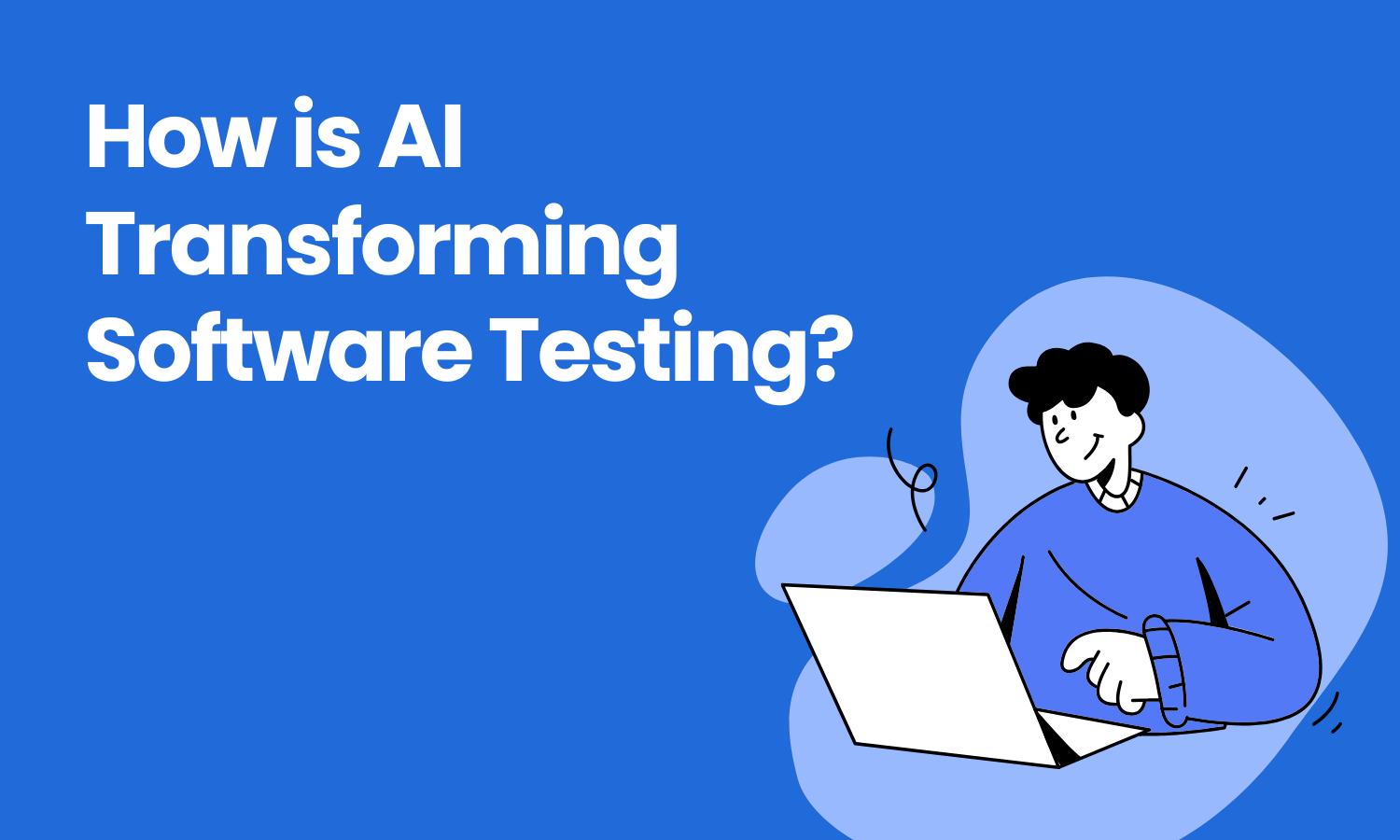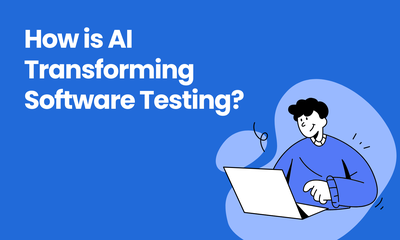How is AI Transforming Software Testing?
By JoeVu, at: March 25, 2025, 11:57 a.m.
Estimated Reading Time: __READING_TIME__ minutes


Software testing is complicated because manual and automated testing processes are not up to the mark.
For instance, when it comes to manual testing, testers have to write and execute test cases in full detail, which makes the entire process cumbersome, error-prone, and even less scalable.
Automated test frameworks were no less problematic affair either. Sure, QA testers have their coding scripts ready for repetitive tasks, which significantly improves the speed and efficiency of the software development cycle; however, some automation tools demand elaborate coding and a high amount of human involvement, which translates into slower software delivery.
Thankfully, that’s not the case with AI tools. AI software testing has made software more straightforward and more efficient. A single prompt can provide a comprehensive testing module, along with bug detection, automation of repetitive tasks, analysis of test performance, and generation of defect-free reports, among many other benefits. Thus, AI is taking software testing to new levels of efficiency and effectiveness.
4 Crucial Ways AI is Transforming Software Testing
Leveraging AI in software testing offers several advantages, such as faster testing, self-healing scripts, predictive analytics, reduced maintenance time, and more. Below are four easy ways to integrate AI into the software testing workflow.
1. Autonomous Test Generation
AI leverages AL and ML algorithms to create and implement test cases for software application testing with minimum human intervention. This approach nails user experience issues and vulnerabilities in software products.
Advantages of autonomous test generation include 1) Time and cost savings, 2) Wider test coverage, and 3) Continuous testing and integration.
Autonomous test generation offers three key benefits.
Time and Cost Savings
Tests are performed mechanically from scratch, so human intervention is not required, leading to faster testing cycles and reduced costs. The most noted feature is that such tests run longer, which speeds up the entire testing process, making it more competent than manual testing.
Extensive Test Coverage
Autonomous test generation is conducted widely, including various tests such as edge cases, rare bugs, and complicated events in situations that human testers generally overlook. This results in the development of software with a lesser probability of failure.
Continuous Testing and Integration
Autonomous test generation easily integrates with CI/CD integration, which ensures testing is a continual process and keeps up with the development pipeline. Simply put, every code change gets automatically tested in real time, helping detect issues early on. Continuous testing ensures faster reviews and bug fixes, eventually improving software quality.
Long story short, autonomous test generation makes software testing faster and more wholesome and effortlessly integrates with the development workflow, which is critical for agile and DevOps practices.
2. Low-Code AI Testing for Faster Development Cycles
Well, it’s a known fact that low-code platforms enable businesses to develop software with less coding quickly. Imagine the development speed when low-code platforms join forces with AI. Shocking, isn’t it? With low code platforms and AI tools working hand in hand, software testers will have ample time to focus on creating test logic and other core aspects of business without getting involved in writing complex codes for test purposes.
Key Features of Low-Code AI Testing Tools
AI-Driven Test Creation
AI tools design test cases automatically using data on application workflows, user behavior, and more. This means AI covers a lot of ground without human intervention.
Reduced Maintenance
When changes are introduced to the code, AI-powered tools automatically tweak tests, removing the need for manual updation of test scripts and thereby significantly reducing test maintenance time.
Visual Test Design with AI
Based on the application’s structure, the AI tools design test scenarios (offering a drag-and-drop interface) and suggest test paths, workflows, and optimizations. This is useful even for non-technical users.
Self-Healing Test Automation
Changes in the application’s UI, locators, or underlying code are automatically identified and tests adjusted using AI-based self-healing features.
Low-cost AI testing tools speed up software development cycles by automating test case creation, reducing maintenance efforts, and, most importantly, helping non-technical users design tests. AI tools' self-healing features ensure that tests are automatically updated whenever code changes occur, ensuring greater accuracy in the testing process. This allows developers and testers to focus on core testing tasks, speeding up development in the process.
3. Predictive Analysis and Maintenance Testing
Test script updates are not easy to do manually. But then, it’s not hard with AI, as AI finds patterns in large data sets, analyzes code changes, and adjusts test cases. Moreover, it can analyze product usage to understand the defect areas. AI then proactively recommends testing those areas to find and repair defects before customers notice them. The predictive approach helps companies cut maintenance costs in a big way and deliver excellent experiences.
Moreover, artificial intelligence analyzes customer and analytics data to predict changing user needs. This foresight and machine learning enable testers to stay ahead of user expectations.
Four key features of predictive analysis and AI-based maintenance testing:
Automated Test Script Updates
AI can tweak test scripts independently by following changes in code patterns, cutting down human involvement in maintaining test cases.
Low Maintenance Costs
AI introduces proactive software testing processes that help forecast areas that seem highly problematic in the software. This reduces the need for manual updates and maintenance costs.
User Behavior and Needs Prediction
AI predicts user behavior by studying customer and usage data, enabling testers to predict and adapt to changing user expectations, which ensures the product stays pertinent to user requirements and, in that process, high-quality user experiences.
AI-based predictive analytics is advantageous because it automates updates, detects defects, and predicts user needs. The approach reduces maintenance costs without compromising product quality.
4. Test Case Rankings
Test cases are ranked on criticality, defect rates, etc. AI analyzes product usage and historical data to finalize which test cases should be run first. This helps testing teams prioritize their efforts on the most crucial tests.
Key Features to Enhance Test Case Prioritization Using AI
Risk-Based Ranking
Test cases are ranked based on risk factors, such as their importance and business impact, not to mention the tendency to generate losses. AI nails these areas by studying historical defects and product modules.
Historical Defect Analysis
AI uses historical defect data and failure patterns to finalize test cases with high defect rates.
User Behavior Insights
Test cases are executed on user behavior patterns. This ensures that the most used features get tested first, enhancing the overall user experience.
Wrapping Up
AI is making software testing quick and easy. Using ML and predictive analytics, testers can trace bugs with higher accuracy and much faster. Low-code platforms powered by AI are game changers of sorts as they come with features that enable test generation and analysis, helping businesses spot issues in advance and thereby plug the gaps quickly.

![[Japan] Freelancing vs. Outsourcing: Why Outsourcing Firms Are a Better Choice for Businesses 2025](/media/filer_public_thumbnails/filer_public/dc/d2/dcd2c053-17c8-4cb7-87ea-086d952ad84c/japan_freelance_vs_outsourcing_firms_1.png__400x240_q85_crop_subsampling-2_upscale.jpg)



